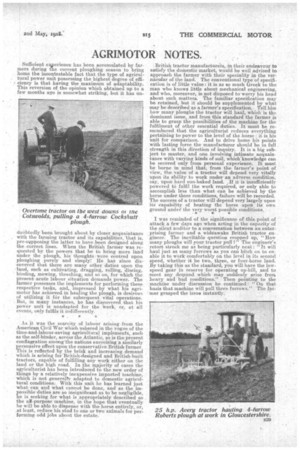AGRIMOTOR NOTES.
Page 17

If you've noticed an error in this article please click here to report it so we can fix it.
Sufficient eisperience has been accumulated by farmers during the current ploughing season to bring • home the incontestable fact that the type of agricul. tural power unit possessing the highest degree of effi • ciency is that having the maximum of adaptability. This reversion of the opinion which obtained up to a few months ago is somewhat striking, but it has un
doubtedly been brought about by closer acquaintance with the farming tractor and its capabilities, That is, pre-snpposing the latter to have been designed along the correct lines. When the British farmer was requested by the powers that be to bring more land under the plough, his thoughts were centred upon ploughing purely and simply:. He has since discovered that there are many other duties upon the -land, such as cultivating, dragging, rolling, discing, binding, mowing, threshing, and so on, for which the present acute labour situation demands power. The farmer possesses the implements for performing these respective tasks, and, impressed by what his agrimotor has achieved in hauling the plough, is desirous of utilizing it for the subsequent vital operations. But, in many instances, he has discovered that his power unit is una,dapted for the work, or, at all events, only fulfils it indifferently.
As it was the scarcity of labour arising from the American Civil War which ushered in the vogue of the time-and-labour-saving agricultural implements, such as the self-binder, across the Atlantic, so is the present conflagration among-the nations exercising a similarly persuasive effect upon the conservative British farmer. This is reflected by the brisk and increasing demand which is arising for British-designed and British-built tractors, capable of fulfilling any work either on the land or the high road. In the majority of cases the agriculturist has been introduced to the new order of things by a relatively inexpensive imported isiachine, which is not generalt.v adapted to domestic agricultural conditions. With this unit he has learned just what can and what cannot be done, and as the impossible duties are so insignificant as to be negligible, he is seeking for what isappropriately described as the al-purpose machine, in the hope that .eventually he will be able to dispense with the horse entirely, or, at least, reduce his stud to one or two animalsfor per= forming odd jobs about the estate.
British tractor manufactureks, in their endeavour to satisfy the domestic market, would be well advised to approach the farmer with their speciality in the vernacular of the land. The conventional type of specification is of little value : it is as so much Greek to the man who knows little about mechanical engineering, and who, moreover, is not disposed to worry his head about. such matters. The familiar specification may be retained, but it should be supplemented by what may be described as a farmer's specification. Tell him how many ploughs the tractor will haul, which is the dominant issue, and from this standard the farmer is able to grasp the possibilities of the machine for the fulfilment of other essential duties. It must be remembered that the agriculturist reduces everything pertaining to power to the level of the horse it is his unit for comparison. And to drive home his points with lasting force the manufacturer should be in full strength in this direction of inquiry. It is a big subject to master, and one involving intimate acquaintance with varying kinds of soil, which'knowledge can be secured only from personal experience. It must be borne in mind that, from the farmer's point of view, the value of a tractor will depend very vitally upon its ability to work under an adverse condition, say, upon hard sun-baked land. If it is insufficiently powered to fulfil the work required, or only able to accomplish less than what can be achieved by the horse under these conditions, failure will be recorded. The success of a tractor will depend very largely upon its capability of beating the horse upon its own ground under the very worst possible conditions.
I was reminded of the significance of this point of attack a few days ago when acting in the capacity of the silent auditor to a conversation between an enterprising farmer and a widea,wake British tractor engineer. The inevitable question cropped up, "How many ploughs will your tractor pull ?" The engineer's retort struck me as being particularly neat "It will haul just as may furrows as you can hitch on to enable it to work comfortably on the level in its second speed, whether it be two, three, or four-horse land. By taking this as the standard, you will have the lowspeed 'gear in reserve for operating up-hill, and to meet any demand which may suddenly arise from: heavy and bad conditions.' Then pointing to the machine under discussion he continued : "On that basis that machine will pull three furrows." The farmer grasped the issue instantly.






















